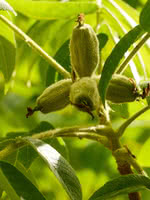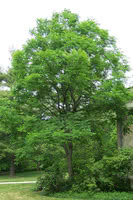Mon-Fri 9am - 5pm Mountain time
Butternut (White Walnut) vs Kentucky Coffeetree
Juglans cinerea
Gymnocladus dioicus
NOT AVAILABLE THIS SEASON - MIGHT RETURN
Butternut is one of the few walnut varieties native to Canada. The nuts are sought after for their mild, sweet, and oily taste. Ensure this tree is planted in full sun and well-drained soil for best results.
Butternut is self-fertile but it has better yields when planted near other butternuts. It can survive in zone 2, but reliably produces nuts in zone 3.
A top CO2 absorbing species. Experts think this tree may help climate change more than others.
The Kentucky Coffeetree has the largest leaves of any native tree in North America! In the summer, its large green canopy provides shade. While in the winter, its leathery bean pods act as a decorative element against the sky as they rattle in the wind. Beautiful year-round, this tree is an elegant addition to any landscape.
Butternut (White Walnut) Quick Facts
Kentucky Coffeetree Quick Facts
Toxicity: Uncooked pods are toxic to humans

